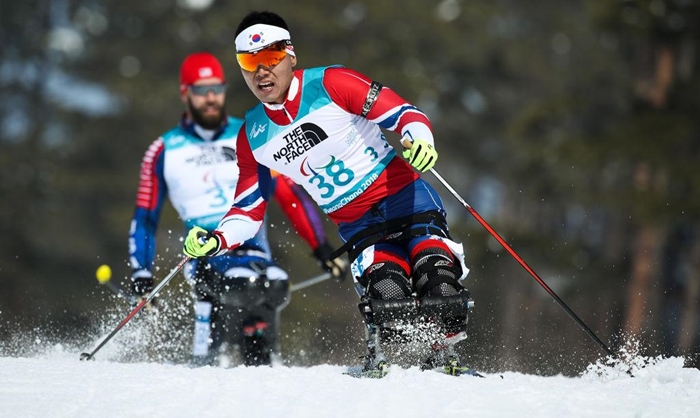| The Olympic and Paralympic games have similar categories, but feature sports that are different in many ways, including in terms of required gear and game rules. Korea.net is here to give you a Winter Paralympics preview. We will compare six Paralympic events with their Olympic counterparts: para alpine skiing, para biathlon, para cross-country skiing, para snowboarding and wheelchair curling. We’ll introduce them as a series to help readers fully enjoy the PyeongChang 2018 Paralympic Winter Games. |

Biathlon athlete Sin Eui-hyun competes in the men’s 7.5km sitting biathlon event in the PyeongChang Paralympic Games, at the Alpensia Biathlon Center on March 10. (PyeongChang Organizing Committee)
By Kang Gahui and Yoon Jihye
It’s helpful to know the differences between para cross-country skiing and para biathlon to enjoy the Winter Games. The former is a form of skiing where skiers go fast across snow-covered terrain, and the latter is a combination of skiing and target practice.
For fairness in terms of the kind of disability, para cross-country skiing and para biathlon are divided into visually impaired(B1-B3), standing(LW1-LW9) and sitting(LW10-LW12) categories.
In both sports, standing and visually impaired athletes have a light boot fixed to the front of their skis, while sitting athletes ride on a single ski with a seat on it.
Sitting athletes compete over a relatively shorter distance compared to standing and visually impaired athletes, and blind athletes ski down the slope while receiving guidance about the course, direction and geographical features from a guide runner through a wireless headset.
In para biathlon, sound feedback through the headset becomes louder as blind athletes aim closer at a target, which helps them to shoot more accurately.
Standing and sitting athletes aim at a 13-mm target, about the size of a blueberry, and visually impaired athletes at a 21-mm target. Just like in the Olympics, if para athletes miss the target, they have to ski around a 150-m penalty loop. However, the penalty loop for sitting athletes is shorter at 100m.
The final scoreis decided by multiplying percentages set according to the sport’s grading system.
Meanwhile, para snowboarding, first introduced here at the PyeongChang Paralympic Games, is classified into upper limb(s) impairment and lower limb(s) impairment.
Para snowboarding has two disciplines, snowboarding cross and banked slalom, and the athlete who finishes three runs down a steep course the fastest wins, and the level of disability doesn’t affect the final score.
kgh89@korea.kr